Garra flavatra
Panda Garra
Etymology
Garra: vernacular Gangetic name for a particular species of “sand-digger,” which Francis Buchanan-Hamilton applied as a generic name for bottom-dwelling cyprinids “with no affinity to another genus”.
flavatra: from the Latin flavus, meaning ‘yellow’, and ater, meaning ‘black’, in reference to this species’ distinctive colour pattern.
Classification
Order: Cypriniformes Family: Cyprinidae
Distribution
Endemic to the Rakhine Yoma/Arakan mountain range in Rakhine state, western Myanmar, which forms a natural barrier cutting off the state from the remainder of the country.
It was originally collected from a handful of streams and rivers of the western, interior, slopes, but Dr. Sven Kullander told SF that it was abundant where encountered and almost certainly has a wider distribution; his team had only four days in which to complete their fieldwork which proved insufficient to explore the region fully. Subsequent commercial collections may therefore have occured at localities additional to those given in the description paper.
Type locality is ‘Thandwe, Kananmae Chaung, near Leldee village, by foot 45 min from Gwechaung village at kilometer 18 on road Thandwe-Taunggok, 8°35’39″N, 94°22’45″E, Rakhine State, Myanmar’.
Thanks to Sven Kullander.
Habitat
The type locality is a shallow (~ 30 cm deep) section of the stream running close to the village of Leldee through what is described as ‘low forest’. At time of collection it was around 3 metres wide and the substrate composed of a mixture of gravel, pebbles and rocks over which flowed clear, transparent water. This was moving quite slowly resulting in the formation of a number of small pools within which the fish were found.
Sympatric species included Rasbora daniconius, R. rasbora, Aplocheilus panchax, Lepidocephalichthys berdmorei, Batasio elongatus, Olyra burmanica, Pterocryptis cf. berdmorei and Sicyopterus fasciatus along with unspecified members of Brachydanio, Devario, Rasbora, Pangio, Channa, Mastacembelus and Anguilla. Garra vittatula, described in the same paper, was also found here although only two specimens were collected compared with 29 of G. flavatra.
In the Kamyit Chaung river it was collected alongside Opsarius barna, Rasbora daniconius, R. rasbora, Aplocheilus panchax, Lepidocephalichthys berdmorei, Batasio elongatus, Awaous personatus, Sicyopterus punctatus plus unidentified Brachydanio, Eleotris, Redigobius, Mastacembelus and Microphis species as well as G. propulvinus, another previously unknown congener.
The river is described as ‘moderately large’ and was again very shallow, the fishes being restricted to a series of shallow pools containing clear, slow-moving to stagnant water. The substrate was again a mixture of gravel, pebbles and rocks and no aquatic plants were observed.
The Baw Di Chaung is the third locality covered in the paper. It flows between forested hills and again the water level was very low, forming a series of riffles and pools with a maximum depth of around 1.5m. The water was totally clear and in some sections flowed with moderate current, in others very slowly. Substrate was predominantly rocks and stones interspersed with open patches of sand.
G. flavatra was apparently found in considerable numbers here but the structure of the substrate made collection difficult and only five specimens were recovered. Other fish recorded were Batasio elongatus, Awaous personatus, Sicyopterus punctatus and Xenentodon cancila along with unidentified Parambassis, Hara, Schistura, Pangio, Channa and Mastacembelus spp. G. propulvinus was again present.
While it may be surprising to learn that this species was not found in oxygenated running water, it is important to note that the streams it inhabits are seasonal in nature; Rakhine is located within a tropical monsoon region and has a pronounced rainy season between May and October, while at other times it can be quite dry. The streams thus swell in depth by a metre or more and flow much more rapidly during the wet season.
Collection of fishes for both scientific and commercial purposes is normally conducted during the dryer months in monsoon-affected areas due to difficulties encountered during times of high water levels and/or poor weather. Despite such annual habitat variations this should still be considered a current-loving fish.
Maximum Standard Length
70 – 90 mm.
Aquarium SizeTop ↑
An aquarium with base measurements of 90 ∗ 30 cm should be the smallest considered.
Maintenance
Not difficult to keep in a well-maintained set-up, but a display arranged to resemble a flowing stream or river, with a substrate of variably-sized, water-worn rocks, sand, fine gravel and perhaps some small boulders, is highly recommended. This can be further furnished with driftwood roots or branches, and hardy aquatic plants such as Microsorum, Bolbitis, or Anubias spp., which can be grown attached to items of décor.
Most importantly, the water must be clean and well-oxygenated with turnover preferably in excess of 10 times per hour; additional powerheads and airstones can be employed to achieve the desired flow and oxygenation if necessary. Bright lighting will promote development of biofilm on solid surfaces, upon which the fish will graze.
Since it needs stable water conditions and grazes biofilm this species should never be added to a biologically immature set-up, and a tightly-fitting cover is necessary since it can literally climb glass.
Water Conditions
Temperature: Normally said to prefer cooler conditions but temperatures in its native streams have been recorded between 22 – 27 °C during warmer months of the year. Presumably during the wet months of the monsoon these values are lesser.
pH: The pH in its natural waters has been measured at 6.9 – 7.1 with a range of 6.5 – 7.5 recommended in aquaria.
Hardness: 36 – 215 ppm
Diet
Although it will graze algae if available this species is not an exclusive herbivore. Offer meaty foods such as live or frozen chironomid larvae (bloodworm), Tubifex, Artemia, chopped prawn, etc., along with good quality, sinking dried products, at least some of which should contain a significant proportion of vegetable matter such as Spirulina or similar.
Fresh fruit and vegetables such as cucumber, melon, blanched spinach or courgette can be offered occasionally and home-made, gelatine-bound recipes containing a mixture of dried fish food, puréed shellfish, fresh fruit and vegetables, for example, are also proven to work well.
Behaviour and CompatibilityTop ↑
Relatively peaceful and makes a good subject for the well-chosen, larger community of stream-dwelling Indochinese species.
It isn’t particularly tolerant of conspecifics but normally exists in loose aggregations in the wild. If kept singly it tends to behave more aggressively with similarly-shaped fishes so we recommend the purchase of 3-4 or more should space permit. Such a group will develop a noticeable pecking order between themselves but tankmates are more likely to be left alone. What appear to be hierarchical disputes will sometimes occur and involve charging, flaring of fins and an overall paling of the body colouration.
Sexual Dimorphism
Sexually mature males develop a series of noticeable tubercules on the head, along the lateral line and around the caudal peduncle, and tend to be slimmer in the body than females.
Reproduction
Has been successfully and repeatedly bred at Hein Aquarium, an ornamental fish export firm based in Yangon, Myanmar. The company have been producing the species on a commercial basis since 2008 in order to avert potential exploitation of wild stocks, and because the fish are time-consuming to collect.
Managing Director Tin Win told us that it’s a seasonal animal which spawns during the months of May to July, and that he collects his brood stock of wild adult fishes during those months. They’re conditioned with algae-enriched dried foods, live Tubifex worms and the occasional chopped earthworm and water flow is maintained at a high rate.
When the fish come into spawning condition individual pairs are selected and moved to smaller, 80 litre, tanks also containing running water which is extracted directly from source via a tube well and has a conductivity of 80 µS, pH close to neutral. It enters the spawning chambers through a spraybar suspended above the surface and exits through a tube fitted into the base which appears to be covered with a gauze-like material to prevent eggs and fry being sucked out (see sketch above).
Eggs are deposited early in the morning and if fertile appear totally transparent with a diameter of ~ 1.5 – 1.8 mm. They hatch in 24-30 hours and the fry derive nourishment from their yolk sacs for another 72 hours or so after which they are fed an egg yolk suspension. In around a week they are large enough to accept Artemia nauplii and once they reach a size of 15 mm or so, the same diet as the adults. Tin Win believes that highly-oxygenated, flowing water stimulates both feeding and growth in the young fish.
Thanks to Tin Hein Win and Hein Aquarium.
NotesTop ↑
G. flavatra first became available to the aquarium hobby in 2005 and became popular almost immediately. It’s traded under various names including ‘panda’, ‘clown’, ‘banded butterfly’ or ‘rainbow’ garra, and is sometimes referred to incorrectly as a loach.
Colour pattern varies considerably between individuals, with some exhibiting particularly intense yellow and red pigmentation, but it’s unclear whether such differences represent natural variation within or between populations.
In addition to this unique colour pattern, it can be further distinguished from congeners by the following combination of characters: rostral furrow shallow and anterior margin of snout elevated in adults; rostral lobe present; proboscis absent; conical tubercles on rostral lobe and along anterior margin of snout; scaled predorsal region, chest and abdomen; two pairs of barbels; lateral line scales 27-29 (usually 28); circumpeduncular scale rows 16.
The genus Garra is a particularly enigmatic grouping with new taxa described on a regular basis, while many of the existing ones may represent cases of misidentification or synonyms of other species. Some of the revisions have also been called into question, which has added further confusion. A full generic review would be ideal but is unlikely to materialise given the extensive distribution of its members which range from southern China across much of southeast Asia, India and the Middle East as far as north/central Africa.
Instead a number of less-extensive works published in recent years have resulted in a gradual, but continuing, improvement in knowledge, and it remains possible that the genus will be broken up into smaller taxa since the current assemblage is almost certainly polyphyletic.
Garra species are usually included in the subfamily Labeoninae/Cyprininae or tribe Labeonini (name varies with author) which by recent thinking is further divided into four subtribes; Labeoina, Garraina, Osteochilina, and Semilabeoina (Yang et al., 2012). The putatively monophyletic Garraina comprises a number of genetic lineages including Garra sensu stricto (which also includes Horalabiosa, Phreatichthys and possibly other genera), a small clade comprising Garra cambodgiensis and G. fascicauda (thus rendering Garra polyphyletic), Paracrossocheilus, and Gonorhynchus (which includes Akrokolioplax).
Two Garra species, G. imberba and G. micropulvinus, are placed in the Semilabeoina assemblage, and the generic name Ageneiogarra Garman, 1912 has been suggested for them, although this does not appear to have been widely followed (e.g. Kottelat, 2013). In addition, some genera which were previously considered to be close relatives of Garra species such as Discogobio, Discocheilus and Placocheilus, are now also placed in this subtribe.
All genera currently included in Garraina possess a lower lip modified to form a mental adhesive disc, allowing the fish to cling to surfaces in turbulent conditions. In most species the upper lip is almost entirely reduced and both the upper and lower jaw margins are keratinised, i.e., horny, and used to scrape food items from the substrate.
Garra species are distinguished from other Garraina members by the first two pectoral-fin rays usually being thickened, fleshy and unbranched, possession of 10-11 dorsal-fin rays, and a combination of internal characters. Some species have evolved particular environmental specialisms such as highly reduced eyes in hypogean forms or the ability to survive in thermal springs.
References
- Kullander, S. and F. Fang, 2004 - Ichthyological Exploration of Freshwaters 15(3): 257-278
Seven new species of Garra (Cyprinidae: Cyprininae) from the Rakhine Yoma, southern Myanmar. - Arunachalam, M., S. Nandagopal and R. L. Mayden, 2014 - Species 10(24): 58-78
Two new species of Garra from Mizoram, India (Cypriniformes: Cyprinidae) and a general comparative analyses of Indian Garra. - Kottelat, M., 2013 - Raffles Bulletin of Zoology Supplement 27: 1-663
The fishes of the inland waters of southeast Asia: a catalogue and core bibiography of the fishes known to occur in freshwaters, mangroves and estuaries. - Stiassny, M. L. J. and A. Getahun, 2007 - Zoological Journal of the Linnean Society 150(1): 41-83
An overview of labeonin relationships and the phylogenetic placement of the Afro-Asian genus Garra Hamilton, 1922 (Teleostei: Cyprinidae), with the description of five new species of Garra from Ethiopia, and a key to all African species. - Yang, L., M. Arunachalam, T. Sado, B. A. Levin, A. S. Golubtsov, J. Freyhof, J. P. Friel, W-J. Chen, M. V. Hirt, R. Manickam, M. K. Agnew, A. M. Simons, K. Saitoh, M. Miya, R. L. Mayden, and S. He, 2012 - Molecular Phylogenetics and Evolution 65(2): 362-379
Molecular phylogeny of the cyprinid tribe Labeonini (Teleostei: Cypriniformes). - Zhang, E., 2005 - Zoological Studies 44(1): 130-143
Phylogenetic relationships of labeonine cyprinids of the disc-bearing group (Pisces: Teleostei).




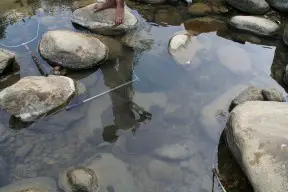


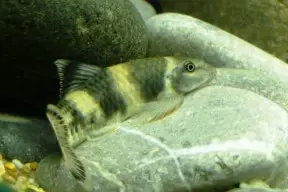
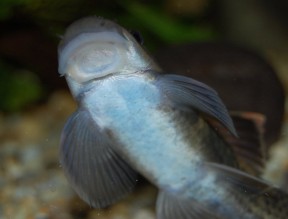
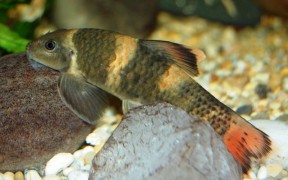
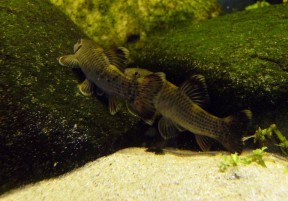

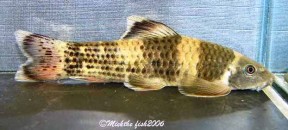
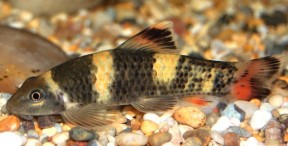


June 23rd, 2012 at 9:00 am
When I tried to emulate a cooler season last winter in my 5x2x2, dropping the temperature from 22C, I became increasingly concerned about my Garra flavatra as the temperature dropped below 21C. By the time it reached 19C, this fish seemed to be spending all its time attached to the FX5 inlet strainer, almost as if the fish was shutting down.
It was then I decided to move the garra indoors to a ~22C 48x12x5 and it immediately became more active and more “normal” in behaviour, pootling around the tank.